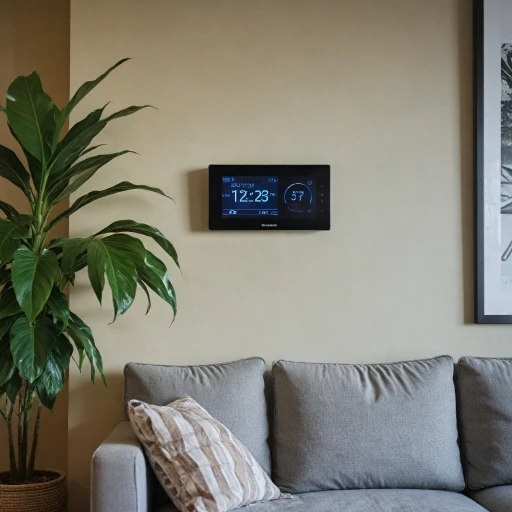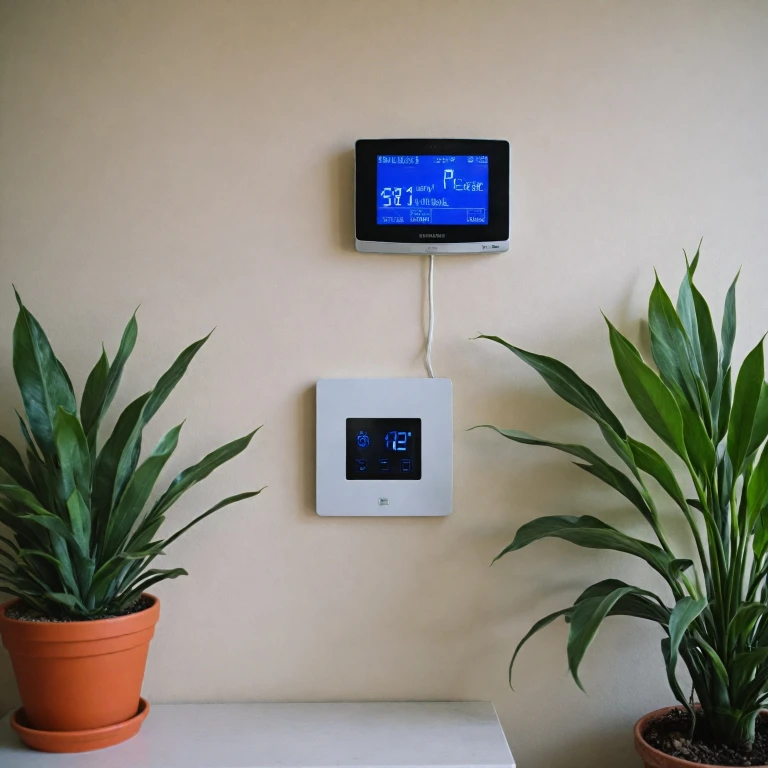Understanding Z-Wave Technology
Harnessing Z-Wave for Seamless Smart Thermostat Control
Z-Wave technology stands out as a game-changer in the realm of smart thermostats, offering a robust framework for managing your home’s heating and cooling needs. As a wireless communication protocol, Z-Wave operates within a specific range, ensuring efficient control of smart devices like thermostats, security systems, and other smart products within the home. This technology creates a mesh network that enhances the stability and reliability of connected devices, making it a popular choice among smart thermostat brands.
Z-Wave thermostats, often a centerpiece of smart homes, allow users to have centralized control over their environment. From adjusting temperature levels to monitoring energy usage, these devices integrate seamlessly with existing home systems and security setups. The battery life of Z-Wave devices, like the popular Honeywell Pro series or TBZ thermostats, is optimized for longevity, ensuring uninterrupted service.
For those new to smart home automation, Z-Wave’s SmartStart feature simplifies the setup process, allowing for a hassle-free connection between thermostats and the rest of your smart home ecosystem. These thermostats not only bring convenience to temperature control but also offer potential energy savings, an aspect explored further in our energy efficiency section.
The Z-Wave standard opens doors to enhanced control over heating and air conditioning systems, including the HVAC system and even specific devices like heat pumps. Whether you opt for the Honeywell Pro Wave thermostat or another trusted brand, Z-Wave provides a secure and efficient way to maintain home comfort. For more on making the most of your smart devices, you might find our
enhancing comfort with smart heated floor thermostats article insightful, as it delves into integrating smart thermostats into various home setups.
Key Features of Z-Wave Thermostats
Features That Set Z-Wave Thermostats Apart
When it comes to smart thermostats, Z-Wave models offer a unique suite of features that distinguish them from other products on the market. For homeowners looking to enhance temperature control while also integrating seamlessly with their existing smart home systems, Z-Wave is a standout option.
Key attributes of Z-Wave thermostats include:
- Remote Management: One of the prominent benefits of Z-Wave smart thermostats is their ability to be controlled wirelessly, giving users the freedom to adjust settings from virtually anywhere. This is particularly advantageous for balancing home comfort and energy efficiency.
- Security and Reliability: Leveraging advanced security protocols, these devices ensure that information remains safeguarded from unauthorized access. This provides peace of mind, especially when integrated with a holistic security system.
- Integration with Smart Devices: Z-Wave thermostats are highly compatible with a wide array of smart home systems. They can work in conjunction with other smart devices, like smart speakers and security systems, enhancing overall home automation.
- Wide Range of Compatibility: Whether it’s a heat pump, a standard HVAC system, or specific thermostat brands like Honeywell, Z-Wave thermostats can handle a diverse range of heating and cooling systems.
- SmartStart Technology: With features like SmartStart, setup is streamlined, allowing for more user-friendly installation and prompt device pairing.
Moreover, if home safety is a priority, Z-Wave series products such as smoke alarms can be effortlessly paired with your thermostat wave for a comprehensive security setup. Explore more on
enhancing home safety with Z-Wave smoke alarms.
In summary, Z-Wave thermostats represent a cutting-edge choice for those seeking efficient temperature management and seamless smart home integration. Their range of functionalities, coupled with reliable security measures, places them as a preferred option in the smart device market.
Energy Efficiency and Cost Savings
Enhanced Energy Efficiency and Reduced Costs
Z-Wave thermostats, like the renowned Honeywell Pro Wave series, offer an exceptional level of energy efficiency that contributes significantly to cost savings. These smart devices provide users with precise temperature control, enabling homeowners to optimize their heating cooling settings in real-time for maximum efficiency. By automatically adjusting to your daily schedule and preferences, a smart thermostat minimizes energy wastage.
Compared to traditional thermostats, Z-Wave products have intuitive features such as the SmartStart function. This allows the system to anticipate the preferred indoor climate by learning how long it takes to reach a specific temperature. Such capabilities ensure that your HVAC system operates only when necessary, prolonging the lifespan of the unit and conserving energy. Additionally, Z-Wave technology ensures seamless integration with various energy management systems, making it compatible with numerous energy conservation initiatives.
Reference to trusted thermostats like the Honeywell Pro Wave and the TBZ series further highlights how brands are leveraging Z-Wave standards to offer smart devices that appeal to homeowners seeking both cost-effectiveness and advanced functionality.
Furthermore, the battery life of these thermostats is optimized, thus reducing the frequency of replacements and contributing to long-term savings. As manufacturers continue to innovate, newer thermostat wave models focus on enhanced battery efficiency without sacrificing performance.
For a detailed understanding of how a thermostat brand like Honeywell integrates these elements into their products, consider exploring
energy-efficient features of the T6 Pro thermostat. This will provide additional insights into how smart thermostats are transforming energy management in households.
Installation and Setup
Steps to Install and Set Up Your Z-Wave Thermostat
Installing a Z-Wave thermostat might seem daunting, but with the right guidance, it's a straightforward process. It's essential to understand the basics of your existing HVAC system and ensure compatibility with your new smart thermostat.
- Preparation: Before you start, switch off your HVAC system to avoid any electrical accidents. Gather necessary tools such as a screwdriver, wire labels, and possibly a drill if a new hole is required.
- Identify Wiring: Remove your existing thermostat cover and take a picture of the wiring to use as a reference. Label each wire using the labels provided with your new thermostat.
- Install the Thermostat Base: Affix the Z-Wave thermostat base to the wall. Ensure that the device is placed at an optimal location, ideally away from any drafts, direct sunlight, or heating sources, to get accurate temperature readings.
- Connect Wires: Using the reference picture and wire labels, connect each wire to the appropriate terminal of the thermostat base. Ensure all connections are secure to maintain the thermostat's functionality.
- Attach the Thermostat: Once all wires are connected, attach the main thermostat unit to the base. Most devices will snap into place, ensuring a tight fit. Ensure the thermostat is level for aesthetic and functional reasons.
- Power Up and Configure Settings: Restore power to your HVAC system and test the thermostat by setting the temperature. Follow the setup instructions in the product manual to configure initial settings such as date, time, and temperature range.
- Integrate with Smart Home Systems: Use the SmartStart feature to streamline the pairing process with other Z-Wave devices. Integration with your smart home system can often be done via the associated app, allowing for refined control and security settings.
While Z-Wave thermostats may have standard installation procedures, the specific series and product features could vary, especially between different thermostat brands like Honeywell. Always refer to the instructions provided by the manufacturer. A successful setup not only enhances your control over home heating and cooling but also taps into the energy efficiency benefits, improving overall comfort and security of your home environment.
Integration with Smart Home Systems
Synergizing With Modern Smart Home Ecosystems
Smart devices have become integral to many households, enhancing convenience and energy efficiency. When you integrate your wave smart thermostat into a smart home system, you open up a world of seamless control and automation.
Firstly, consider the compatibility of your thermostat with other smart devices in your home. Wave thermostats, including the renowned Honeywell pro series, are designed to work smoothly within popular smart home ecosystems, such as security systems and various HVAC system setups. This integration capability allows you to manage your heating and cooling more efficiently, utilizing centralized controls.
Most wave series thermostats feature SmartStart, which helps optimize your energy usage by learning your schedule and preferred settings. By syncing with smart devices, you can maintain a comfortable temperature while being energy-conscious. Moreover, advanced control options allow for remote management of your heating and cooling systems via mobile apps or voice commands through smart assistants.
Several thermostat brands offer extensive pro wave series options that support direct integration with home automation platforms, ensuring secure and reliable connectivity. Tools tailored for easy integration, such as the TBZ thermostat and other system products, ensure that energy management and temperature control can be done effortlessly from any location within the range of your network.
Ensuring a wave thermostat fits into your smart security system also brings a layer of safety. For example, monitoring your home's temperature while you are away or automating responses to specific environmental changes enhances not only security but also peace of mind.
Ultimately, integrating a wave thermostat with your smart home system elevates home energy management. It provides a comprehensive, centralized control solution, making it a wise investment for those seeking to enhance their home's energy efficiency and functionality through advanced smart home technology.
Troubleshooting Common Issues
Resolving Common Errors in Wave Thermostats
Navigating issues with smart thermostats, like the popular wave series, can be daunting. However, understanding and resolving these common problems can ensure optimal performance of your device.
One prevalent issue with wave thermostats is connectivity. Ensuring that your device remains properly connected to your wave network is crucial. It may help to check the range and positioning of your thermostat within your smart home system. Products from renowned thermostat brands like Honeywell are designed with enhanced signal reception capabilities, but obstacles such as walls or large furniture can still impede the signal.
If your wave smart thermostat is not responding as expected, the problem could be related to energy supply. Verify the battery status or the power connection. Consistent energy flow is essential for the device's operation, especially for models in the series wave portfolio.
Temperature inconsistencies could also stem from incorrect HVAC system settings. Ensuring that your smart thermostat accurately reflects your heating and cooling preferences requires initial configuration during installation and setup. It's essential to regularly cross-check these settings with the device's control options and your desired temperature range.
Adjusting security settings can also mitigate potential threats to your wave thermostat. Many smart devices, including the tbz thermostat and honeywell pro models, offer options to integrate within broader security systems. Properly configuring these settings can protect against unauthorized access and ensure your home’s thermal comfort.
Regular maintenance and software updates are recommended to prevent functionality issues. These updates often include enhancements that improve your product’s compatibility and performance, which are incremental but valuable for any wave devices.
Addressing heat pump issues within the wave thermostats can often require professional support, especially if it involves complex heating cooling systems. Trusted service providers can help in troubleshooting intricate aspects beyond basic user solutions.

